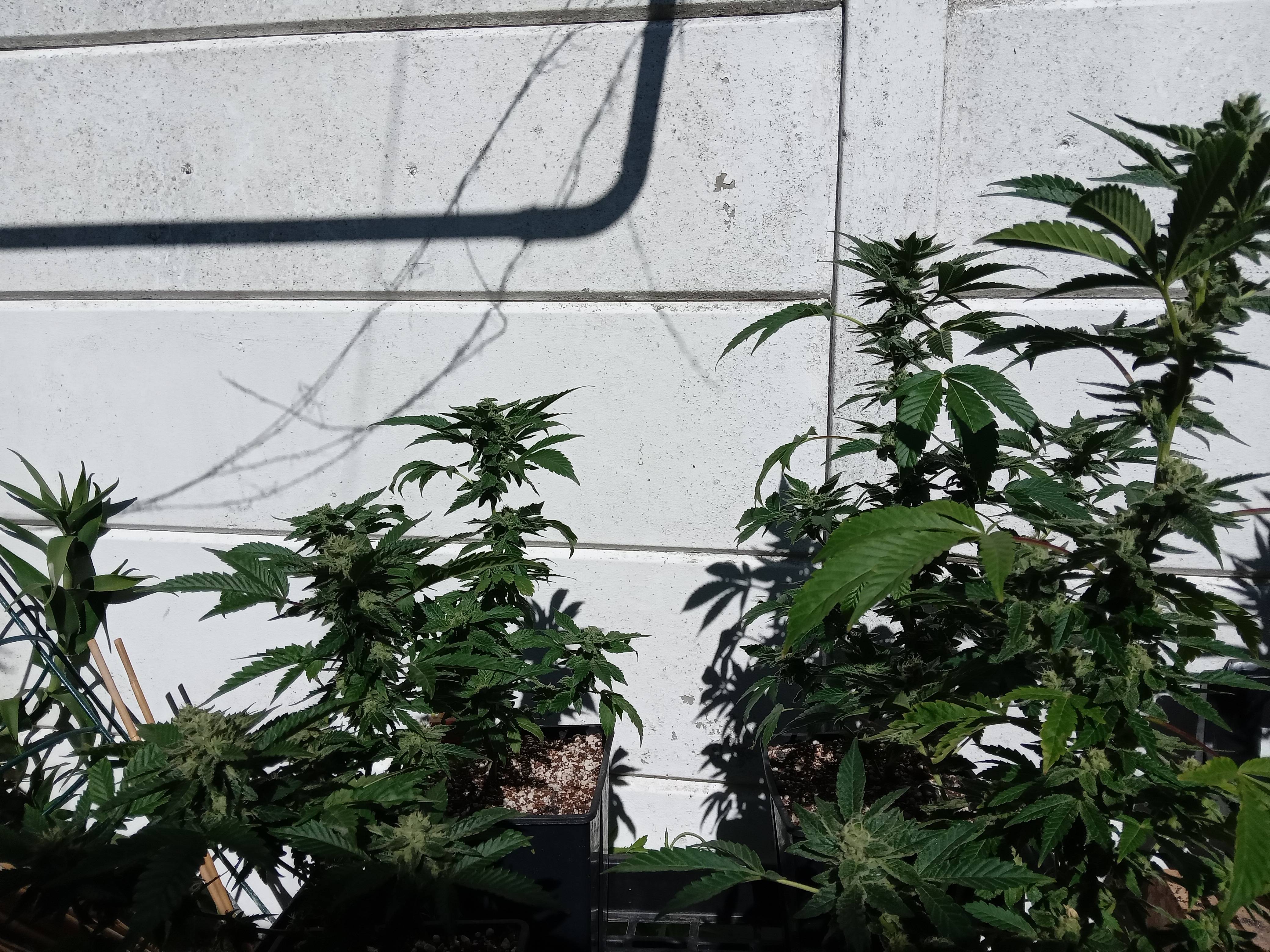
Twix Aphen
Regular Member-
Posts
401 -
Joined
-
Last visited
-
Days Won
2
Content Type
Profiles
Forums
Calendar
Gallery
Articles
420 Directory
Classifieds
Everything posted by Twix Aphen
-
Hi again. Your pictures have prompted me into action. Today I've used some potassium sulfate spread over the the garden and it shall be washed in with the next watering, or rains again soon if we are lucky. https://organitek.com/potassium-deficiency-in-cannabis-plants/ https://www.cannabisbusinesstimes.com/nutrition-plant-health/cannabis-plant-nutrition/article/15687380/how-much-potassium-does-cannabis-really-need
-
Hello, what do you think it is causing the discoloration and the burn holes? It looks like the media has either run out of potash, the coco wasn't buffered and rinsed properly or the silica has kicked the pH out of range and potassium is unavailable. One or the other, those plants are showing a deficiency of K
-
Good evening Naughty, glad my info was useful to you. Buying plants ready for flowering must be a bonus and they're right on your doorstep too. A long time ago a person who owned a postnet franchise told me exactly how to get my seeds through cape mail. Never use a courier, only the national postal service. Use standard airmail post only, the letters are rarely if ever checked. The package must weigh under 150 g and be sent in a standard size envelope, no bigger than A5. SA Customs ask for duties on certain goods over the value of R500, so ask the sender to mark the value accordingly. A bulky item will get opened and checked 9/10 times. Seeds in vial in a taped up padded plain envelope will arrive un-opened. Its been a long while since i ordered them, but i think the shipping costs were $18 and the packs were $50 each.
-
Good evening, I live in Cape Town. I can send them in a clone transporter by courier
-
Hey there. They're from the US and will post out here. They send 2 for one and other good deals. I know about dagga farmacy, I told you about them a couple of years back and also gave you the directions to get there.
-
R120 each, they are rooting the jiffy glue plugs. I took 9 clones yesterday.
-
Only spray micronised calcium onto the leaves because the particles are small enough to be absorbed into the foliage. I have never sprayed any calcium, I only add I to the soil. I can send you a little care package for your 6 girls if you are keen. I've got some good clones from deadpanhead here as well. https://deadpanhead.com/chem-ny
-
This is a care package i I am putting together for a fellow grower and also what I mix together for my plants. I add in calcitic lime, diatomaceous earth and volcanic rock dust. My fertilizer is also top dressed. I make it with soybean meal and oilseed meal And I add the myco tablets to my water to kick start the breakdown of all the dry amendments. When potting up I dust the roots with myco granules too
-
This is my plant. When it arrived it was pot bound and hungry. I could see that it showed the stress with purple stripes on the main stem and fully purple side shoots. Purple petioles and burnt leaf tips. In a 10 litre pot I added 2 tablespoons of lime and 2 of gypsum. Within a week the new growth is green without the stripes and purple. The old leaf stems remain purple bit the new growth is lush green. Now she is much happier with no burnt tips
-
Bonemeal is added to the mix in the beginning, i would put 240 ml or one cup into a 20 litre pot. After 6 weeks I will then also top dress every 3 weeks, until harvest.I would add 60 ml a quarter cup, or 4 table spoons. It looks like you need more calcium than the bonemeal can provide, but it will help. I also use gypsum and calcitic line to ensure that the levels of calcium remain sufficient throughout the grow.
-
https://www.stodels.com/product/gardeners-gold-dust-5kg-2/?srsltid=AfmBOopNX0-H2GpD1XSR468xfZwsuEKVO0D3-zAaHkc6xER5DP9k5za_
-
Bonemeal has adequate calcium in it and so does Gardners gold dust (gypsum). Half a cup of either one will remedy this deficiency. Molasses has some calcium but not enough to deal with your issue. One plant showing the symptoms just means that that is a heavier feeder, or the soil it grows in didn't get amended with enough Ca. I will take a few pics of my plant later and show you how I corrected my own deficiency with two table spoons of Gardners gold dust.
-
Burning along the leaf margin is also a sign of its progression. Some of your leaves are burning along the edges.
-
If it was natural coloring then it wouldn't appear overnight. A cold snap of weather could trigger it, but it wouldn't just show up on the leaf stem. That is the early sign of a nutrient deficiency. Your plant needs more calcium brother
-
https://journals.ashs.org/hortsci/view/journals/hortsci/44/6/article-p1566.xml
-
How's it? Purple petiole can be the natural coloring, or due to the cold. The most common cause is a deficiency of calcium. Do you have burnt leaf tips too?
-
Synthetics - Mycorrhizae Killer
Twix Aphen replied to Marzcanna's topic in Organic Growing - Growing in soil
@ORGANinc. The secret sauce is to properly chelate the elements, before they come into contact with the roots and foliage. Alginic acid and mannitol are both chelating agents and are constituents of kelp. As you know, kelp is closely related to algae. It looks like a good product from Greenhouse, but why is it R2100 for a kg There's a few ways to improve the chelatiin, depending on your style of cultivation. Compost holds onto nutrients and the microbes cycle the nutrients. A minimum of 20 % organic matter in your medium is a great way to achieve this balance. A teaspoon of well made worm castings contains 50,000 different species of microbes. Less fertiliser is required if its assimilated into an available form and also buffered by carbon. Magnesium sulphate + fulvic acid = magnesium fulvate. A lot of sulphate compounds are approved for organic use, but they can be improved exponentially when mixed with humates. I use gypsum with my worm castings. The calcium is then synthesized into a chelated compound, called calcium humate. Calcium is responsible for delivering 7 other elements into the plant tissue. @PsyCLown I think that using these myco products is a better strategy than using toxic fungicides and pesticides. Treating the seed to prevent damping off is a wise move, in the field. Especially if the soil is marginal and needs improving. Your label says 150 g per hectare, but Indoors where the seed are planted individually, in a disease free environment then I don't think it makes much difference. The row on the left is the control, next 3 have had plant matters myco and the 3 on the right side had mycoroot. Trichoderma species are biotrophic mycoparasites, but they can turn necrotrophic. If your trichoderma turns necrotrophic, it will then kill off the harmful Fusarium, but it doesn't revert back into the biotrophic state. Once its in seek and destroy mode, your beneficials are also at risk. https://en.m.wikipedia.org/wiki/Mycoparasitism However, in some combinations, the parasite may live during its early development as a biotroph, then kill its host and act more like destructive mycoparasites in late stages of parasitism. -
Synthetics - Mycorrhizae Killer
Twix Aphen replied to Marzcanna's topic in Organic Growing - Growing in soil
Microbial enhanced nutrition delivery, is the phrase he uses and also "There's a microbe behind every mineral" I think he farms with 18,000 apple trees and produces millions of apples every season. He says our farmers in SA are leading the world, when it comes to turning around the agricultural decline and rebuilding the soil's fertility. A lot of these strategies for building up the fertility with no till, teas and inoculants are for Broadacre, pasture lands and orchards. I'm not so sure that they scale down, or are appropriate for our small garden use. There are only 2 known species of Endo mycos (glomulus) that form any relationship with weed. Do any myco products list the spores they contain? It can take up to 10 weeks for the symbiosis to establish. If there's already an abundance of soluble P in the soil, then the mycos can remain dormant, or even turn parasitic against the host species If you use trichoderma in your potting mix then it will dominate over other species. Its the most aggressive fungi in the soil and it chows up other mycos, in its wake. -
Synthetics - Mycorrhizae Killer
Twix Aphen replied to Marzcanna's topic in Organic Growing - Growing in soil
@Marzcanna I like me pavlis, he isn't trying to sell anything and says it straight. Have you read his opinions on fish fertiliser? Another good website is called horticultural myths, by a lady called Linda Chalker-Scott. If you apply too much nitrate, organic, synthetic or whatever, then it burns out the carbon and you strip away the fertility of your ground. You create a feeding frenzy, boom and bust scenario. Use organic matter, compost, humic acid and fulvic acid and don't go too heavy on any fertiliser. Organic fertilizers work well with compost and OM, as do synthetic salts. -
Anyone have any experience with Hortimix powder
Twix Aphen replied to Grow for the love's topic in Indoor Growing
I'm ready to start feeding with the hortimix now. I will probably go for 1:1 a&b to start, then 1:1:1 a b & mkp for later flowering with a bit of extra Epsom salts added in.ghe 1 litre bloom formula can be replicated with 110 g mkp and 20 g of Epsom salt. This is the npk values when I convert the powders into liquid. I think ripen is slightly different composition, mainly mkp, with some potassium sulphate, magnesium nitrate and potassium nitrate in smaller amounts. If the label on the bottle lists the g/kg then you can also work backwards to find out the SG, w/w and w/v to get the exact proportions for each component in any fertiliser compound. -
@CoolJDid you need an invite, or can you just rock up at the gate and load up the car boot? @Naughty.Psychonaut check your inbox
-
That's funny, my friend gave me the tops of 2 plants that were too big for his boot, He got a tour of the farm and could pick any plants he liked.
-
There's a fine sight. How big are the clones when they arrive and how much did they cost? My hash plant x Blueberry were originally bought from a farm, near Paarl. Apparently there's a sign at the gate saying Hemp Plants For Sale. They are the fastest and easiest plants I've got growing, also mildew/Eskom resistant too. You also don't know what it was treated with either. They could potentially be sprayed with a cocktail of poison to keep the mildew and bugs away.
-
Good day, I sprayed all over the surface of the coco and then let the nutes wash it through into the gutter. I did it every 3 days or so, when the lights went on, just before the irrigation cycle started. It took 10 litres to dose the whole tent (2.4 x 2.4). I think I used 3 x 50 ml bottles over the duration. Not many countries allow spinosad to be sold over the counter and in California it's on the banned list for cannabis. The efekto pamphlet only recommended a drench for lawns, to kill caterpillars. These aphids have got a waxy shield that protects them so I used the highest dosage recommend. According to Cloyd, “Root aphids may hide under the root ball thus allowing them to escape exposure to any insecticide residues. Systemic insecticides may not be effective against root aphids as insufficient (non-lethal) concentrations of the active ingredient may not accumulate in the roots where they are feeding.” I've spoken to another grower about this problem and their solution was to remove any effected plants and destroy them. Then in the remaining plants, use an aphicide that he applied once a week, until he was sure they didn't return. He used a neo nicotinoid which is something I personally think should be banned
-
Its winter and curfew, I'm not out and about at night time so I need a hobby Yeah thanks, happy days. They went into flower last week end. Your ones must be nearly finished by now?



